Blum W., Riegler W., Rolandi L. Particle Detection with Drift Chambers
Подождите немного. Документ загружается.


10.4 Accuracy of the Ionization Measurement 341
Fig. 10.8 Va ri ati on o f t he
single-gap relative width with
the particle velocity factor
βγ
, according to the PAI
model for an argon sample of
1.6 cm length (N.T.P.).
(Adopted from [ALL 80],
Fig. 4.1)
(see Sect. 1.2.4). Does W depend on the particle velocity? This must be suspected,
because the number of primary interactions does, and so does the cluster-size dis-
tribution, although only very weakly. In the PAI model also this detail has been
computed. We see in Fig. 10.8 the dependence of the relative width W/I
mp
on the
relativistic velocity factor
βγ
, which reflects the characteristic shape of the ioniza-
tion curve. In the example at hand, which is 1.6 cm of argon, W /I
mp
oscillates inside
a narrow band of (80 ±7)%as
βγ
increases from 1 to the plateau. One concludes
that the velocity dependence of the relative width can usually be neglected in this
range.
10.4.3 Variation with the Gas
We finally have to involve the properties of the gas itself; they will determine the
absolute scale of the accuracy
δ
I/I when px and n are specified. The pulse-height
distributions of many gases have been measured in single and multiple gaps. From
the work of the Lehraus group [LEH 82b] we present in Fig. 10.9 a compilation
of measured single-gap ionization widths of various gases at different densities. It
turns out that the noble gases have wider distributions than the organic molecular
gases.
With the PAI model, Allison and Cobb calculate for argon ([ALL 80], equation
4.3) a value which represents some average over the particle velocities:
δ
I
mp
/I
mp
= 0.96n
−0.46
(px)
−0.32
(FWHM). (10.9)
A systematic comparison between different gases is possible using the dimen-
sionless scaling variable
ξ
/I = 2
π
Nr
2
e
mc
2
x/(
β
2
I) . (10.10)
We have encountered the variable
ξ
with the dimension of an energy, as the
main factor in the Bethe–Bloch formula (1.65) determining the energy lost in
the gas thickness x, to be multiplied only by a
β
-dependent factor of the or-
der of unity. (N = electron density, r
e
= classical electron radius = 2.82 fm,
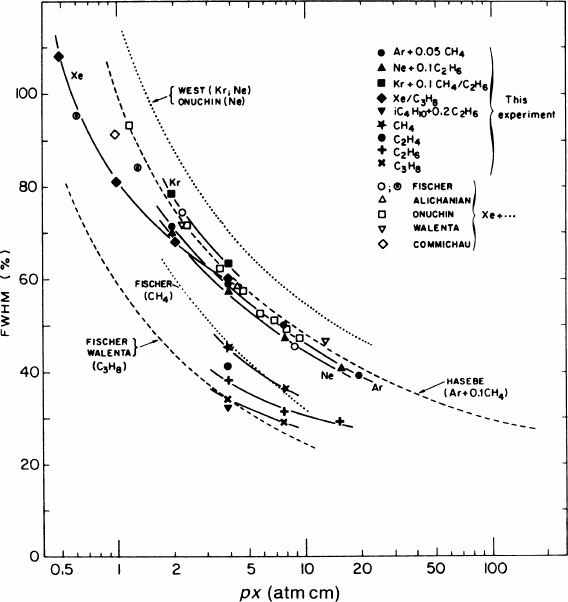
342 10 Particle Identification by Measurement of Ionization
Fig. 10.9 Single-gap resolution measured for various gases and pressures [LEH 82b] as a function
of the product of pressure p and sample length x
mc
2
= rest energy of the electron,
β
= particle velocity in units of the velocity
of light.) We have also met the variable
ξ
as the scaling factor (1.49) in the Landau
distribution.
The mean ionization potential I is the only constant in the Bethe–Bloch formula
that characterizes the gas; see Table 1.3. The ratio
ξ
/I will be roughly proportional
to the number of electrons liberated over the distance x, and therefore it is plausible
that it might serve in a comparison of accuracies
δ
I/I.For
β
= 1 and gas layers of
1cm,
ξ
/I takes on the values 0.32, 0.50, 0.62, 0.65, and 0.70 for the noble gases
He, Ne, Ar, Kr, and Xe at N.T.P., respectively.
From the work of Ermilova, Kotenko and Merzon [ERM 77], Fig. 10.10 con-
tains calculated values of the width of the ionization distribution in a single gap, for
various noble gases, plotted as a function of the ratio
ξ
/I. The full width at half
maximum is expressed in units of
ξ
. We notice that the points of the different gases
and sample lengths x fall roughly on one universal curve, which only depends on
ξ
/I. We also notice that for
ξ
/I near 1 the theoretical predictions for the width of
Landau and Blunck–Leisegang (see Sect. 1.2.5) differ by half an order of magni-
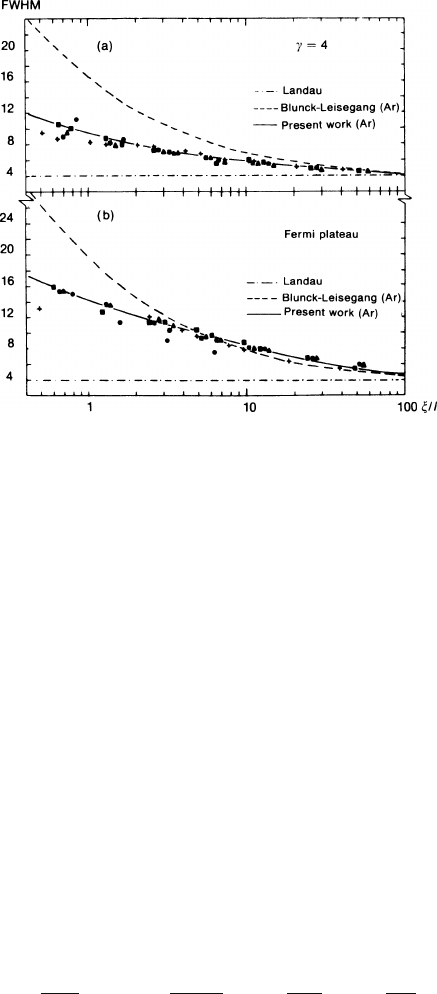
10.4 Accuracy of the Ionization Measurement 343
Fig. 10.10 The widths of the ionization distributions in units of
ξ
for the noble gases, calculated
for various sample lengths by Ermilova et al., plotted as a function of
ξ
/I (10.10) [ERM 77]. The
points calculated by a Monte Carlo method follow a universal dependence of
ξ
/I
tude; on the other hand, the Monte Carlo calculation of Ermilova et al., which is
very similar to the subsequent PAI model, accurately predicts the measured widths.
The three calculations and the experimental points fall generally together only for
ratios
ξ
/I larger than about 50.
Using the universal variable
ξ
/I Allison and Cobb generalized relation (10.9) for
all gases:
δ
I
mp
/I
mp
= 0.81n
−0.46
(
ξ
/I)
−0.32
(FWHM). (10.11)
It should be emphasized that this formula has not yet been tested experimentally in
a systematic comparison between different gases. The value of the constant is equal
to the value of 0.96(
ξ
/I)
0.32
for 1 cm of argon.
In (10.11) the length of the device is contained in
ξ
and n, the gas pres-
sure in
ξ
. If we want to make their influence more visible we may calculate
from (10.9) the relative accuracy obtainable with a device 1 m long containing
argon gas at N.T.P., and 100 samplings; the result is
δ
I
mp
/I
mp
= 0.115. The
value of
ξ
varies between different gases in the ratio of their atomic charge
number Z. Therefore we have for the general case of a gas, characterized by Z
and I,
δ
I
mp
I
mp
= 0.115
1mbar
Lp
0.32
Z
Ar
I
ZI
Ar
0.32
100
n
0.14
(FWHM), (10.12)

344 10 Particle Identification by Measurement of Ionization
where L is the length, p the gas pressure and n the number of samplings; I
indicates the average ionization potential as used in the Bethe–Bloch
formula.
10.5 Particle Separation
In order to judge the power of particle separation for a certain gas and wire arrange-
ment we must combine the results of Sects. 10.2 and 10.4. Generally speaking, the
figure of interest is the ratio
δ
I/(IR). The noble gases have a wider pulse-height
distribution but also a larger relativistic rise, compared to the hydrocarbons investi-
gated. The same compensation is at work with the gas density: as the accuracy
δ
I/I
becomes better with higher density, the relativistic rise R gets worse; in addition the
saturation of the plateau starts at a lower
γ
∗
. Finer sampling is an advantage even
in the approximation (10.4). In addition, there is the tiny increase, if any, of R with
finer samples.
The performance of various gases, according to calculations with the PAI model,
is compared in Table 10.2 [ALL 82]. These results refer to normal density and to
tracks 1 m long, which are sampled in 1.5 cm intervals. The relativistic rise R is
indicated for the most probable value of the ionization distribution and for the lower
and upper points at half maximum. The full width W
66
of the ionization determina-
tion derivable from a maximum-likelihood fit to all 66 measurements is also shown.
The last 6 columns contain particle-pair separation powers S, i.e. for a given pair of
particles at some momentum the difference of the peak positions, divided by W
66
.
Remarkably, the separation powers of different gases are very similar.
Measurements of the separation power for various gases and pressures have been
performed in a beam of identified particles by Lehraus et al. [LEH 82b]. In their de-
tector with 64 cells, each 4 cm long, they determined simultaneously the difference
between the ionization of electrons, pions and protons and the accuracy
δ
I (r.m.s.
width of the distribution). The gas and its pressure were varied. Considering the sep-
aration of these particles at 15 GeV/c, the results are expressed as the ratios D/
σ
,
equal to
I
π
40
−I
p
40
δ
I
π
40
or
I
e
40
−I
π
40
δ
I
π
40
, (10.13)
plotted against pressure in Fig. 10.11. This diagram contains a summary of much
careful and systematic study. We observe a general decrease below 1 bar and often
a decrease above 2 bar, although there are several gas mixtures, where the pion–
proton separation increases up to 4 bar. In any event, the values of the ratios stay the
same within a few tenths between 1 and 4 bar.
Single-gap measurements in three gases were reported by Walenta et al. [WAL 79]
at 3.5 GeV/c. The measured ratio of peak displacement over the full width is plotted
against pressure in Fig. 10.12. An increase in separation power can be observed at
pressures above 1 bar. The overall picture is that with some gases a profit can be
made by going above 1 bar.
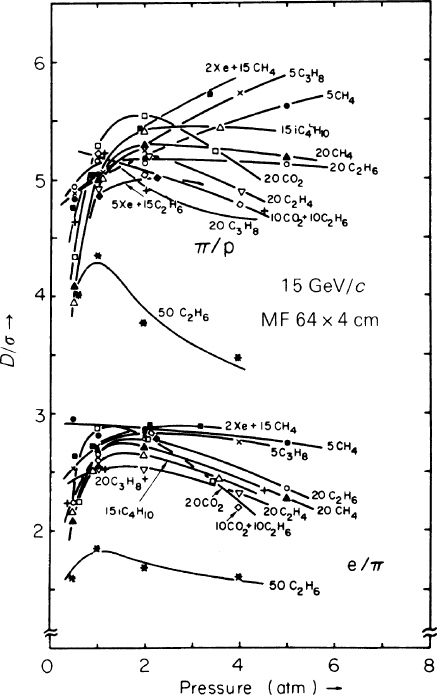
10.6 Cluster Counting 345
Fig. 10.11 Pressure dependence of the resolving power (10.13) for various argon gas mixtures, as
measured by [LEH 82a] at 15 GeV/c. The numbers close to the chemical symbols of the quench
gases refer to the concentrations; for example, 20CH
4
means 80% Ar + 20%CH
4
10.6 Cluster Counting
The statistical distribution of the number of ionization electrons produced on a given
track length has a width W (measured at one half of the maximal probability), which
was plotted relative to the most probable ionization I
mp
in Fig. 1.12 as a function
of the track length. This width is determined by the fluctuation in the number of
primary clusters that occur over this length and by the fluctuation in the cluster size.
It is the latter that dominates; for example, there are 28 primary clusters on 1 cm
bar of argon whose Poissonian fluctuation is only 44% FWHM, whereas W/I
mp
is
approximately equal to 1, and for 10 cm bar of argon, the corresponding numbers are
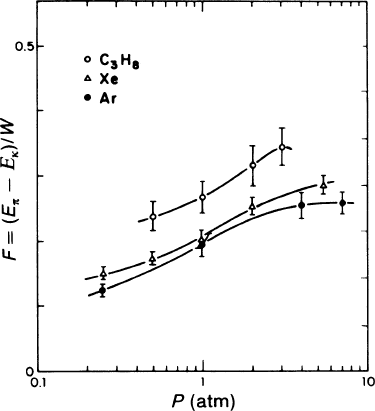
346 10 Particle Identification by Measurement of Ionization
Fig. 10.12 Single-gap
measurements for three
different gases by
[WAL 79a]: ratio of the peak
displacement between pions
and kaons at 3.5 GeV/c to the
width of the distribution,
plotted as a function of the
gas pressure
14% compared to W/I
mp
≈ 0.5. The cluster-size distribution P(k) (see Sect. 1.2.4)
dominates because of its 1/k
2
behaviour at large k.
Since the number of primary clusters is given with much more relative accu-
racy than the corresponding amount of ionization, one would like to make use of
it for particle identification. The primary ionization cross-section, as a function
of velocity, has a similar behaviour to the ionization curve, the slope of the rela-
tivistic rise being essentially the same. The plateau, however, is reached at a lower
saturation point; this makes the total relativistic rise R
p
from the minimum to the
plateau somewhat smaller than it is for the amount of ionization. For details see
Allison [ALL 80].
Measurements of the relativistic rise of the primary ionization cross-section were
reported by Davidenko et al., who used an optical streamer chamber filled with
helium at 0.6 bar [DAV 69]; they measured R
p
= 0.38 (difference between plateau
and minimum divided by the value at the minimum). Blum et al. found R
p
= 0.6in
Ne(70) + He(30) at 1 bar using spark chambers [BLU 74]. Although a systematic
evaluation of primary ionization curves is lacking, the effect is obviously strong
enough to make the counting of individual ionization clusters a method which is
interesting because of its promise of accuracy – if only a way could be found to
separate clusters in drift chambers.
One proposal was made by Walenta [WAL 79b]. In his ‘Time Expansion Cham-
ber’, described in more detail in Chap. 11, the drift region is electrically separated
from the amplification region; by using a very low drift velocity, it is possible to
separate individual clusters in time and to register individual electrons with some
efficiency. The basic problem in argon at atmospheric pressure is that the clusters
are so close to each other (28 per cm in the minimum) that even a small amount of
diffusion will wash out the primary ionization pattern. For larger distances between
clusters one would have to employ lighter gases and/or lower gas pressures. We are
not aware of any particle experiment which has successfully used cluster counting
for the identification of particles.
10.7 Ionization Measurement in Practice 347
10.7 Ionization Measurement in Practice
The large multiwire drift chambers provide many coordinate measurements on each
track, and more often than not this includes recording the wire pulse heights. These
are then a measure of the ionization density of each track segment, provided the
chamber is operated in the proportional regime. In the universal detectors the parti-
cles go in all directions, and their ionization is sampled in different ways, depending
on how the track is oriented with respect to the wire array that records it.
There are also more specialized drift chambers, which were built with the express
purpose of particle identification behind fixed-target experiments. There, the parti-
cles travel generally into one main direction, which makes the ionization sampling
much more uniform than it is in the universal detectors.
For good ionization measurements a balance has to be found between two con-
flicting requirements. On the one hand, the wire gain must be kept small in order
to have a signal accurately proportional to the incoming ionization charge. When
the gain is too large, the amplification will drop when the incoming charges are
concentrated along a short piece of wire, owing to space charge near the wire (see
Sect. 4.5), resulting in a gain variation with the amount of diffusion and the track-
wire angle. Furthermore, the positive ions created in the wire avalanches penetrate
to a certain extent into the drift space, where they cause field and hence track and
gain distortions. On the other hand, large signals are required for the coordinate
measurement in order to overcome the electronic amplifier noise; this is particularly
important for coordinate measurements along the wire, using charge division.
The pulse integration must work in such a way that the result is exactly pro-
portional to the collected charge, and especially that it is independent of the length
of the pulse. Otherwise it has to be corrected by a function of the track angle and
the drift length, which both have an influence on the pulse length. In order to have
a clean pulse integration, overlapping tracks must be eliminated with some safety
margin. The number of signals on a track in the middle of a jet of other particles can
therefore be considerably reduced. It is not uncommon that in a large drift chamber
the average number of signals is only little more than one half of the number of
wires that could in principle measure a track.
In order to derive a meaningful ionization of a track, truly independent of all the
external circumstances of the measurement, a number of calibrations and correc-
tions are required at the percentage level of accuracy. These may be grouped in two
categories, according to whether or not they depend on the track parameters.
10.7.1 Track-Independent Corrections
Without going into the details, we just mention the following effects which change
the apparent ionization and therefore have to be kept under control: gas density
(pressure and temperature), concentration ratios of the components, electron attach-
ment, base line and pedestal shift of the electronic channels.
348 10 Particle Identification by Measurement of Ionization
The response of the individual wires must be the same throughout the drift cham-
ber. At first sight one may argue that the wires measuring the same track are allowed
to have inequalities among each other up to a value small compared only to the
fluctuations of a wire signal (say small compared to 70%). On a closer look, the
requirement of uniformity is more stringent, because the situation changes from one
track to the next. A group of wires may not contribute to the next track because
the track is displaced or because it overlaps with other tracks. So in practice the
wire response must be equalized to a narrower measure. A quantitative evaluation
would obviously have to take into account the geometrical details of the situation.
Although such equalization can be achieved by determining a correction factor for
each wire, matters are simpler when the hardware is already made quite uniform
by respecting tight tolerances on the gain and time constants of the charge-sensitive
amplifiers.
10.7.2 Track-Dependent Corrections
The amount of track ionization collected on one wire of a grid plane depends on the
track orientation. Let
α
be the angle between the track and the plane, and let
β
be
the angle in the plane that the projected track has with respect to the normal to the
wire direction (a track parallel to the wire has
α
= 0 and
β
= 90
◦
). The length x of
track contributing to a signal is equal to x
0
/(cos
α
cos
β
), where x
0
is the distance
between sense wires. We know from Chap. 1 (Fig. 1.10 and the discussion after
(1.49)) that the most probable value I
mp
of the ionization is not a linear function of
x but can better be approximated by
I
mp
(x)I
mp
(x
0
)=(x/x
0
)(1+C
1
ln(x/x
0
)), (10.14)
where the value of C
1
can be obtained from Fig. 1.11 or from a Monte Carlo simula-
tion, or experimentally by grouping wires to make larger x;C
1
is typically between
0.1 and 0.3. The signals from every track segment have to be divided by the factor
(10.12) in order to be normalized to the standard length x
0
.
The effect of saturation is described by a length
λ
on the wire over which the
incoming electrons are distributed;
λ
is equal to x
0
tan
β
and has to be convoluted
with the transverse diffusion, which in turn is a function of the drift length z. A first-
order correction could be the following expression, which depends on a constant C
2
:
I(
β
)/I(90
◦
)=1−C
2
/
λ
(
β
,z). (10.15)
This correction is complicated because it is a function of the drift length z as well as
of the angle
β
; it is also not quite independent of the amount of ionization itself and
of the angle
α
.
In a geometry where the wires run orthogonal to a magnetic field, the E ×B
effect causes the drifting electrons to arrive on the wires at an angle
ψ
(Fig. 7.5a-c);
in this case
λ
is equal to x
0
tan(
β
−
ψ
).
10.8 Performance Achieved in Existing Detectors 349
The signal attenuation due to electron attachment requires a correction which
depends on the drift length z through a constant C
3
:
I(z)=I(0)e
−C
3
z
. (10.16)
Electronic cross-talk between wires can give rise to an
α
-dependent correc-
tion because the small ‘illegal’ pulses induced on neighbouring wires are prompt,
whereas the normal signal develops according to the arrival time of the electrons.
The time differences between the normal and the small induced pulses depend on
α
and will give rise to a variation in the pulse integration.
The corrections discussed above are all interconnected, and it is difficult to isolate
the individual effects. In fact, we do not know a particle experiment in which such
a programme has been successfully completed in all details. Nonetheless, with the
corrections applied, in practice it has usually been possible for the determination of
track ionization to reach a level of accuracy that is not far from that predicted by
(10.9). The reader who is interested in more details of the correction procedure is
referred to the articles by the groups of ISIS2 [ALL 82, ALL 84], OPAL [BRE 87,
HAU 91], CRISIS [TOO 88] and ALEPH [ATW 91].
10.8 Performance Achieved in Existing Detectors
It is appropriate now to describe a small number of wire chambers used in particle
experiments and to compare their ionization-measuring capability with the theory.
Although a systematic discussion of existing drift chambers begins in Chap. 11, we
want to include a few devices here as examples in the context of ionization measure-
ment. We distinguish specialized chambers and universal detectors. The emphasis
is on measurements in the region of the relativistic rise.
10.8.1 Wire Chambers Specialized to Measure Track Ionization
As the progress in accelerator technology made fixed-target experiments possible
in particle beams with momenta up to one hundred GeV/c or more, the relativistic
rise of the ionization in gases was put to the service of identifying the secondary
particles. The first and largest such undertaking was the External Particle Identi-
fier (‘EPI’) behind the Big European Bubble Chamber (‘BEBC’). It consisted of a
stack of 64 rectangular chambers, each 1 m high, 2 m wide and 12 cm deep. Verti-
cal proportional wires – surrounded by field wires – were strung to make sensitive
regions in the gas, shaped like rectangular boxes, 1 m high, and with a 6 × 6cm
2
ground surface, two layers to a frame, each layer 32 boxes wide; see Fig. 10.13.
This arrangement was used as a multiwire proportional chamber hodoscope – the
coordinate information came in steps of 6 cm horizontally, but vertically there was
no subdivision. The ensemble of the 64 frames was 8.5 m long (deep) and weighed
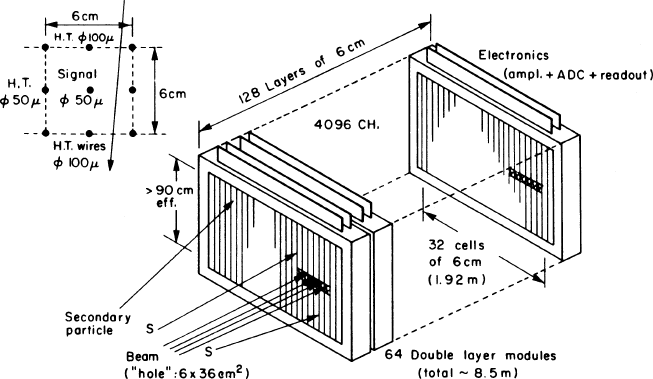
350 10 Particle Identification by Measurement of Ionization
Fig. 10.13 Layout of the External Particle Identifier and cell structure. The position of the insen-
sitive beam hole is indicated
16 ton. Mounted four metres above the ground, it still looked small compared to the
big magnet of BEBC, which was nearly 16 m away (centre to centre), so the solid-
angle coverage of secondary particles was only 8 m sr. The whole apparatus had to
be movable sideways in order to be able to accept at least a small fraction of the
secondary particles that had the same charge sign as the incoming beam. The lim-
iting aperture was a hole in the iron mantle of BEBC through which the secondary
particles had to leave the zone of interaction.
If the spatial resolution was modest, the same can be said for the time resolution.
The device had to register all the events in one burst, which lasted for only 3μs.
These details are important in the context of pattern recognition and an unambiguous
association of track segments.
For the ionization measurement, enough length was available to reach a very fine
precision. For beam tracks, Lehraus and collaborators reached a resolution of 6 to
7% FWHM, varying slightly with particle species and momentum. This is almost as
good as the theoretical limit of 5.8% derived from (10.9) based on the PAI model.
In Fig. 10.14 we see the ionization of beam tracks consisting of protons and pions
with a momentum of 50 GeV/c. The resolution is so good that a clean identification
of almost every individual particle is possible.
When analysing tracks that emanate from interactions in the bubble chamber,
one loses track segments overlapping with others in the same region (box) of sensi-
tivity. This loss in the number of ionization samples N is an important cause for the
observed deterioration of resolution. The resolution in this overlap region seemed
to deteriorate more quickly than according to the rule N
−0.46
or N
−0.43
discussed
in Sect. 10.4.1 for clean measurements. In EPI the average number of samples N
that remained above a minimal requirement N
min
, for example, was between 72 and
